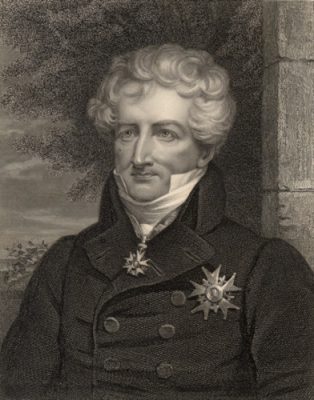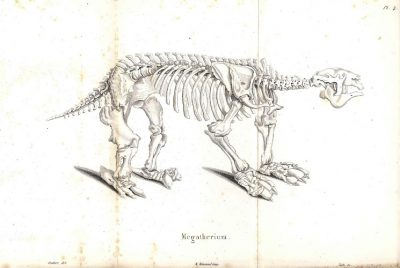Georges Cuvier
PDF
Both had proposed bold hypotheses about the relationships between different groups of living organisms, hypotheses that contributed more or less directly to the emergence of the theory of evolution:
- Cuvier had established, on the basis of their anatomy, four large groups of animals, four completely distinct and original organizations, without possible relationships between them: Radiated (sponges, corals, echinoderms…), Molluscs, Articulated (arthropods) and Vertebrates.
- Geoffroy Saint-Hilaire, on the other hand, considered correspondences, “analogies”, between the structures of these distinct “organizational plans”, going so far as to consider the anatomy of a lobster as an “upside down” equivalent of that of a vertebrate (external skeleton against internal skeleton, ventral nerve chain against dorsal, dorsal circulation system instead of ventral…).
The “quarrel of the analogues” that opposed Cuvier and Geoffroy Saint-Hilaire in 1830 captivated both naturalist scientists like Goethe, from Prussia, and socialites like Balzac, in Paris [1].
With the success of Darwin’s theory of evolution, historiography has mainly retained the confrontation of Cuvier and Lamarck, author in 1809 of an evolutionary theory according to which organisms could transform from one generation to the next:
- by “the heredity of the acquired traits”: the physical characteristics acquired by the parents during their lifetime – their muscles, for example – would be transmitted directly to their offspring;
- and by “the use and non-use of a character”: a structure would tend to disappear when it is not, or no longer, “useful” to the organism; it would develop, on the contrary, if it had a direct benefit for the individual [2]).
Cuvier is accused of not only stifling Lamarck’s innovative theory, but also of not hesitating to ridicule his opponent again when he delivered his eulogy in 1829.
Cuvier’s moral criticism, more than scientific, is also based on the character’s social trajectory: a young native of Montbéliard of modest origin, Cuvier ended up being knighted by Charles X in 1819, after an uninterrupted social rise despite the political, economic and social upheavals that marked the Revolution, the Napoleonic Empire and the Restoration. Cuvier was therefore caricatured in the 20th century as the typical representative of reactionary positions (social conservatism of the 20th century bourgeoisie and scientific conservatism with Catholic bigotry), as opposed to Lamarck (the visionary who would have been right too early) and Geoffroy Saint-Hilaire (the bold iconoclast and probably agnostic).

At the same time, Cuvier’s anatomical expertise had enabled him to demonstrate that some fossil skeletons did not correspond to any living animal (Figure 2). Explaining their past existence while refusing transformationism led Cuvier to consider “revolutions of the Globe”, each revolution making the previous fauna disappear before another one emerged and developed. The current notion of crisis is a reinterpretation of this “catastrophist” vision, now compatible with the theory of evolution, since no crisis has ever been able to eradicate all living species.
References and notes
Cover image. Portrait of Georges Cuvier by James Thomson (1789-1850) [Source: [public domain], via Wikimedia Commons]
[1] Hervé Le Guyader (2017) Etienne Geoffroy Saint-Hilaire. Un naturaliste visionnaire. Belin, coll. Alpha, 448 p. – ISBN: 978-2-4100-0609-4. For a review of the book, see C. Langlois (2017), on the Planet-Terre website.(in french)
[2] It should be noted that this idea, although mistaken, is still firmly rooted in the general public’s conception of the evolution of species!
[3] This argument of the impossibility of “intermediate” organizations is still used by anti-evolutionist movements. However, if the argument was relevant against Lamarck’s theory, it is not valid against Darwinian evolution, which is based on populations of individuals slightly different from each other.




